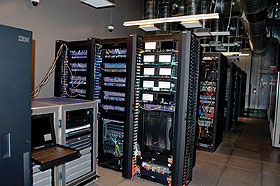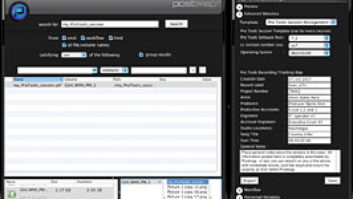
Technicolor’s central hub allows for projects, dailies and other production elements to be viewed while sharing time-stamped comments and playlists.
It’s a common scenario. It has been decided to move forward by 10 days the final sound-editorial sessions so that the composite dialog, effects and music tracks will be ready for the first day of predubs. So the supervising sound editor brings on a swing gang of eight more editors. Where are the Pro Tools and Logic Pro sessions on the in-house server; and which interconnected WAN holds the re-edited Foley elements from Vancouver, and the last-minute ADR tracks voiced yesterday in England? Wrangling such a large number of digital audio and video files needs a steady hand, and one more vital component: a well-implemented media asset–management strategy that allows everything to be tagged and labeled, and then stored where the editorial and mixing teams can quickly find them.

Chuck Parker, Technicolor’s chief commercial officer
For post-production facilities—and the engineers, editors, mixers and creatives who provide them with component sound and picture elements—tracking media during a complex workflow poses major asset-management challenges. Not only must individual files be cataloged and indexed upon ingest, the companion metadata also needs to be integrated into an easily accessible database utility available at each connected workstation. The key, of course, is easily locating an asset, identifying its current status and delivering it to the DAW or mixing console for editing into a composite soundtrack. It then must be made available for offload as a deliverable asset to the client. And it had better be the right version!
Asset management covers all types of media and metadata files—from acquisition to post-production/mixing to archive. Key features of a well-designed media asset–management solution include overseeing all target resources, regardless of format or source, and offering enhanced collaboration across the media enterprise, including production and post. Such an integrated system has to recognize all forms of data-storage topologies—video and audio—and LAN/WAN network access, ideally, should be via conventional IP-based client tools, with easy-to-implement metadata searches and automated workflow throughput.
“We track assets as an extension of our work orders and master catalog numbers in our JD Edwards digital vault system,” says Kelli Clark, senior facility engineer at Fox Post Production Services. “We store BWAV-format files on our storage-area network servers and archive to LTO tape. Our main pain points are tracking the various versions of audio files generated during a film project, and making sure that they accurately reflect various picture changes, which may occur after the mix is completed. What versions have already been entered into the vault that need to be recalled and updated?
“Our new digital vault is under construction here in Los Angeles, with a disaster-recovery center in another to-be-determined remote location,” Clark continues. “When completed, the vault will offer well over a petabyte of storage, using Quantum’s StorNext file systems on high-speed, RAID-format arrays [connected to] Linux servers.”

Kevin Collier, director of engineering, post-production services, at Warner Bros. Studio Facilities, Burbank, Calif.
ACCESS GRANTED
Consistent naming conventions are a major headache when initiating and maintaining asset-management databases. “It’s a bit like painting the Golden Gate Bridge,” Clark says, with a knowing grin. “You are constantly culling data and updating asset information, only to find more waiting to update when you think you are done!”

Ed Elliott, Technicolor’s senior solutions architect, Digital Delivery Group
“We tailor our storage and asset-management according to different classes of user,” says Kevin Collier, director of engineering, post-production services, at Warner Bros. Studio Facilities, Burbank, Calif. “We utilize various group-rights available via the Linux operating system to keep users from accidentally stepping on one another; editors and mixers have carefully assigned rights to parts of our online storage. For example, we might digitize an edited picture as a proxy file so that editors can cut sound effects against that version; they can only access the images, however, with sufficient rights. We add various levels of granularity to provide enhanced security for our assets and those of our third-party clients. And we generate a high-quality digital picture file to our in-house standard for the dub stages. To prevent unauthorized access, the file is only accessible from a separate, private network [on the server] at the locked projection booth.”
Warner Bros. Studio Facilities has standardized a four-character file-name header that defines the film or TV project, and then adds more characters to define the file’s revision or version number. “Users can log onto our proprietary, password-protected servers—what we refer to as the PPSnet—and see a folder-based [interface] that is divided into separate areas for editorial and stages,” Collier continues. “Editors locate the sound and image files they need, and then, if authorized, pull them off the server for access on local drives and then push them back as edited files with appropriate file-name revision numbers so that each digital asset is unambiguously labeled. Deeper-level folders hold, for example, pre-dubs, stems and final masters,” the latter sub-divided into English-language, foreign-language, M&Es and so on.
Separate disaster-recovery and archive mechanisms ensure that these assets are continuously protected and accessed long after the project is completed. “Our Disaster Recovery comprises a mirrored copy of the main RAID-5 server on a back-line array, which is updated daily,” the director of engineering says. “We have approximately 500 terabytes of spinning storage on which we keep material for the life of a project, and then, following the release date, will stream it off to an LTO tape library, which is a snapshot backup of the mirrored server. Then we perform a digital archive to twin sets of LTO tapes and a set of DVDs holding the mixed stems and print masters. Why DVD? Who knows if the DAWs we use today will be around in 10 years’ time; we selected an archive format that lets us recover flattened files from a film or TV project.”

Jim Frantzreb, senior market segment manager at Avid
Robert Smith, systems and media engineer at Sony Pictures Entertainment’s Digital Studios division, stresses that a successful asset-management scheme requires accurate and consistent metadata. “We use a proprietary naming system,” he reveals. “Because of the degree of specificity we need in sound editorial, the file names can become rather long. For Sony projects, we use a powerful renaming tool to provide consistent titles for dialog and effects files, for example, before transferring them to specific sub-folders within a main project folder. To ensure full compatibility across all asset management, our archive program also uses the same nomenclature.” For third-party projects, Sony retains the originally supplied file names because such media metadata is not held on the database.

Kelli Clark, senior facility engineer at Fox Post Production Services
Like other post facilities, Sony Pictures opted for a high-speed Quantum StorNext server in a RAID-5 configuration for local storage. “We have about 300 terabytes of local online storage and access to much larger off-site cloud-storage options,” Smith says. “We also have an 8-terabyte cache for the tape archive, which has become read-only. When a file-retrieval request is made, Store Manager pulls that material from tape, writes it to the 8-terabyte cache and it becomes available to fulfill the work order. We are now writing all of our new incoming material to off-site cloud storage at the Digital Media Center. That material in the cloud is then written to LTO5 tape and, after a period of time, deleted from the spinning media.” The off-site location uses Isilon Systems storage and the Sony Petasite tape library.
“Our proprietary utilities provide secure access to dailies, projects needing approval and other marketing material we need to send out to remote facilities via the Internet from Sony Pictures’ Digital Media Group,” Smith continues. “The asset-management system links directly to our databases to provide worldwide fulfillment of sound and picture elements.” Sony Pictures uses ClearStory Systems’ ActiveMedia platform to create digital systems for transporting, sharing and organizing stock footage and related marketing materials with post, print and finishing houses.
At FotoKem, a Burbank, Calif.–based post facility, senior VP of technology Paul Chapman says, “Currently, assets are ingested and cataloged using our existing physical asset-management system,” but that process will be automated in the near future. “We have a large combination of RAID-protected systems with more than 600 terabytes of spinning storage holding our video and audio files,” he explains. “Our editors pull down these files to a local workstation using our work order–controlled system, and then push them back after project completion. We use a storage area network for real-time playback of uncompressed materials that need enhanced bandwidth for large video files, and more cost-efficient network-attached storage for less-demanding local storage. We archive to LTO4 and LTO5 tape.”
Technicolor provides a wide range of creation, management and delivery services for entertainment-content providers. It also recently announced the creation of a new film/broadcast post-production facility at Paramount Studios’ lot in Los Angeles, including ADR, Foley and dub stages. The new facility will use Technicolor’s file-based digital workflow, connecting to other facilities around the globe via Technicolor Production Network (TPN).

At Warner Bros., editors and mixers have assigned rights to part of the facility’s tape library.
According to Ed Elliott, Technicolor’s senior solutions architect, Digital Delivery Group, the company uses interlinked asset-management systems to control the flow of production elements and final deliverables. “We use a variety of solutions to oversee asset flow from ingest to delivery,” he explains, “using accurately defined metadata to describe the source and authorized destination—plus rights management—of each individual digital file. During acquisition and production, assets within our managed ecosystem are available for secure review by applications such as MasterVUE and ShareVUE, dependent upon the access rights granted to the person accessing the databases via a highly secure viewing application.”
To ensure consistent descriptions across such a wide range of assets, “a standard naming architecture is essential,” Elliott emphasizes. “We actively support the Interoperable Master Format, which is developing standardized descriptors for file contents and content-delivery codecs, for example, which form the metadata labels.”

FotoKem senior VP of technology Paul Chapman
Technicolor’s ShareVUE is a proprietary application that allows authorized users to access collaborative dailies during the post-production process via a workstation, tablet or smartphone. Encoded media is uploaded to Technicolor’s encrypted, private cloud-based server for secure viewing in a remote location; robust content-protection protocols include link encryption, content scrambling and dynamic watermarking. A central hub allows for projects, dailies and other production elements to be viewed while sharing time-stamped comments and play lists. Secure access of assets for verified users is based on a mutual authentication login and expiring URL links.
A new Media Storage Service from Technicolor combines enterprise storage and data-management expertise from disc-store vendor NetApp to manage digital assets; the NetApp “secret sauce” provides highly optimized storage area networks and/or network-attached storage for post facilities and content providers. “The new service offers a ‘pay-as-you-go’ pricing model, allowing our customers to scale storage to meet fluctuating demand and avoid over-investing in off-peak periods,” offers Chuck Parker, Technicolor’s chief commercial officer. Technicolor’s customers “can provision the [cloud-based] storage they need in days instead of weeks, accelerating completion of projects,” he says. “We married NetApp storage expertise with our own expertise in video.” The service is directly integrated with MediAffinity, Technicolor’s digital content-management and access platform.
“Our core business is about manipulating content—everything from visual special effects at the very beginning of the chain through production and post-production,” Parker continues. “Today, we face storage challenges. A new TV show might need up to 500 terabytes of data for 26 weeks of shooting and then—bang—it goes away when the show is over. With that kind of workflow, we need to turn on storage very quickly and then archive and retrieve it.”
“A cloud service is about a shared infrastructure that can be turned up and turned on,” adds Rick Condgon, NetApp’s Western area VP. “And then when one of our clients is done with that infrastructure, they can give it back and we can re-deploy it again to another customer; that is a very cost-effective solution. We know data management, and Technicolor knows about workflow.”

Robert Smith, systems and media engineer at Sony Pictures Entertainment’s Digital Studios division
THE AVID SOLUTION
If you work in sound or picture, you will eventually encounter Avid. Avid offers a pair of integrated media-asset solutions that accommodate both Media Composer and Pro Tools session files, plus component audio and video digital media. Interplay Production Asset Management (PAM), as the name suggests, is designed for in-house workflows, while Interplay Media Asset Management (MAM) handles cross-platform and delivery mechanisms to enable completed material to be reused, repurposed and monetized by content providers. Optimized for all steps in a real-time media-production workflow, PAM allows users to track production file formats at every instance of a project’s history, with versioning, non-destructive rollback, collaborative access and role-based front ends.

“Interplay Production was initially developed for broadcast and video customers,” says Jim Frantzreb, senior market segment manager at Avid. “We will continue to add new functionality, with audio workflows being one of the next logical steps in the product’s continued development. The audio-production aspect of the current Interplay Production workflow focuses on Interplay-connected Media Composer—or Symphony or NewsCutter—editors delivering projects to Interplay-connected Pro Tools systems, and then Pro Tools editors delivering mixes to the Media Composer or Symphony for finishing.”
While the current Interplay Production release does not have specific functionality for Pro Tools-to-Pro Tools workflow or the ability to automatically populate audio-specific metadata, “It can help streamline the workflow of audio professionals who work on extreme time-sensitive projects,” Frantzreb explains, “such as promos, daytime dramas, cable programming, et cetera. By optimizing these ingest and delivery operations, Interplay Production can sometimes double the audio creative time available per assignment. [We] will continue to work closely with our customers on how best to address Pro Tools/audio-specific metadata.”
Interplay Production allows users to find and browse content, and then perform frame-accurate annotation or shot-listing, either locally or across a WAN. Ingest scheduling through a dedicated or Web-based user interface lets a facility use a conventional workstation’s OS to access and monitor asset databases across a wide range of third-party media servers.
The post community puts unusual demands on file access and media-asset management, Warner Bros’ Collier concludes. “We need the flexibility of working with serial and parallel workflows. In reality, we deal with working asset management and not curated asset management, where the materials are fixed and unchanging. It is a major challenge for Warner Bros. and other post facilities.”
[A Thank You footnote: In addition to the people mentioned in this article, the author would like to thank the following individuals for their invaluable assistance while researching the subject:
David Hansen, VP of sales at SanSolutions, which offers a number of integrated storage systems for post facilities.
David Evans, VP of technology solution sand services from P1 Technology, and formerly with NBC-Universal; P1 offers a number of storage and disaster-recovery solutions for post facilities.
John Mallory, product manager at NetApp Media Solutions, which offers a range of SAN/NAS storage media options from high-capacity SATA disk drives to contiguous server farms.]
Mel Lambert has been intimately involved with production and broadcast industries on both sides of the Atlantic for more years than he cares to remember. He is now principal of Media&Marketing, a Los Angeles–based consulting service for the professional audio industry.




